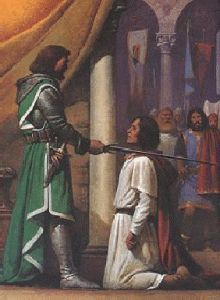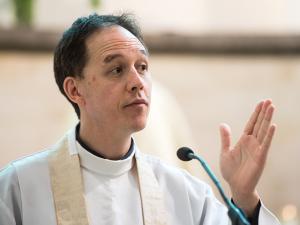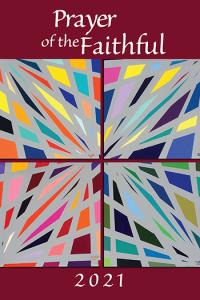
I was nearing the end of a presentation on the Mass to a Confirmation class. I got to the period of silence after Communion. How to explain the purpose of this moment after having emphasized repeatedly that Liturgy is the work of the people? It’s like the case of a difficult job that’s finally done. Tool belts come off. Before you open up the cooler, or maybe between gulps of liquid refreshment, you stand and stare at the completed project. It’s a kind of silent honor that you pay to a foe that almost, but not quite, had you beat.
I told the students that the work Jesus expects us to accomplish in each Mass can be a similarly formidable challenge. I didn’t mean our everyday work, for which the grace of the Mass gives us strength and courage. I meant the work that occurs when we participate meaningfully in the Liturgy itself. The work of giving all honor and glory to God and keeping for ourselves none of that glory we pursue to separates ourselves from others. The work of forgiving those who trespass against us and offering them peace. Finally the work of joining—all unworthy—in procession to be united mystically with the Body of Christ, with Head and members, the ones we so easily and often wall off from ourselves.
That work accomplished and the Communion Procession over, we sit in silence. It’s that moment of the long and loud exhale. My words never measure up to the occasion. But I’ve been on the receiving end of praise for my small contribution to some project from a more experienced builder. And here I can faintly discern praise from the Master Liturgist, in whose work I was privileged to take my part.
Making silence in the Liturgy work a little better
Silence in the Liturgy needs to be purposeful and clearly meant as silence. Fr. David Friel, a blogger on Views from the Choir Loft, says liturgical silence is not
a mere pause between one moment of celebration and another that follows. Rather, it is to be considered a true and proper ritual moment, complementary to the proclamation of the Word, to vocal prayer, to song, to gesture, and so on. (“Silence in the Liturgy ”)
The General Instructions of the Roman Missal calls for silence:
- before the prayers of the Penitential Rite
- After the Scripture readings and after the Homily
- After “Let us pray” introducing the Opening and Post-Communion Prayers
Of these, in my experience of Liturgies, the first seems to work fairly well. The second works when the presider pauses before rising for the Gospel Acclamation and when he pauses after the Homily. Not working so well are the silences after the First Reading and after the Psalm. Neither does the silence after “Let us pray” introducing the prayers work.
In the latter cases there is a brief moment without sound, but it’s not a silence that is purposeful and actually looks like silence. Always something is going on. A reader or singer is moving toward the microphone. A server is approaching the presider and carrying a big book. We see these movements and it looks like that’s what the pause is for!
In a truly silent time nothing else but silence would be happening. It wouldn’t be hard. Simply have the server come with the book before “Let us pray.” Let there be a pause before the cantor gets up to sing the Psalm and before the lector moves to the ambo for the Second Reading.
Silence of anticipation
The General Instructions says there are various types of silence. The silence after a reading is supposed to be a time of reflection on what one has just heard. I have to admit that I find that hard to do. When I have been able to do it, it seems that I have turned the Liturgy of the Word into a study time rather than a celebration. I wonder if it wouldn’t be more helpful to think of this silence as a time of looking forward rather than back.
When I read stories to my children, and now my grandchildren, I don’t find that they think back on a story I’ve just read. They say, “Read me another.” It’s no lack of appreciation for something to be hoping for more of the same. It might be profitable to think about the silent periods during the Liturgy of the Word as silence of anticipation. It’s also realistic. We look forward to another reading after the first one, after the Psalm, and after the Second Reading. We look forward to the Homily after the Gospel. And, if we thought about it, we would look forward to our common Profession of Faith after the Homily has done its part to encourage us to manifest our faith.
The silence during the Penitential Rite could be very much the same. We know we are sinners, but even more we look forward to the mercy of God, which we name during this part of the Mass and experience in the rest.
Before and after Mass
In my parish it’s usually quiet, after the Rosary, before Mass starts; and it’s noisy when Mass is over. I think that’s appropriate. Before Mass, among the thoughts coursing through our heads may be some whisper of anticipation of the mystery about to unfold. At the completion of that mystery, well, there was that quiet post-Communion time. After that the Liturgy itself doesn’t call for any silence. Some do remain quiet for a time, and I don’t think the surrounding noise bothers them. Some parishes make almost a requirement of quiet time after Mass. It’s a respectful gesture to Jesus present in the Tabernacle. On the other hand, I don’t think happy noise ever bothered Jesus.
The stillness of a pre-winter snowfall and approaching Advent’s quiet waiting are what have turned my mind to thoughts of silence in the Liturgy. I wish for you a happy, peaceful season of preparing the way of the Lord.
Image credit: Classic Body’s Brain Food via Google Images












